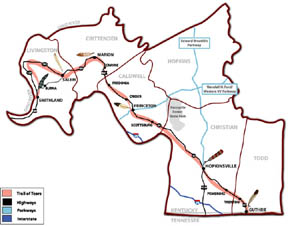 |
|
|
|
|
|
|
 |
|
This website is in the beginning stages of development, please check back soon for more information and photos.
|
|
|
| The History |
| In 1830, President Andrew Jackson pushed through Congress the Indian Removal Act. Cherokees, Statesmen Henry Clay, Daniel Webster and others fought the Removal Act and won in the Supreme Court. Jackson refused to honor the ruling and by the middle of the 1830's, a handful of Cherokee had been tricked into signing a removal treaty known as the New Echota Treaty of 1835. This treaty decreed that the Cherokee give up their lands and remove to a 13 million acre territory in Oklahoma. Gold had also been discovered in Daheoena, Georgia and white men coveted the land, so the President accepted the treaty and the Cherokees were helpless to defend themselves. In 1838, the Cherokees were forced to start out on their march toward the Oklahoma territory. 7000 troops were sent under the command of General Winfield Scott by President Jackson. At gun point or bayonet, they were herded into crude stockades, previously prepared at Rattlesnake Springs near Charleston, Tennessee. They were given no time to gather clothing, families or supplies. They were subjected to starvation, heat, disease and mistreatment all summer. The Indians were charged for their food, clothing or other meager supplies. The sick, aged and children were to ride in the wagons, but there was not enough room. The trip took five months through six states, traveling 2200 miles. |
|
The Route |
| In October of 1838, the first detachment left Rattlesnake Springs and crossed the Tennessee River and were marched under cruel military escort into Nashville. Traveling five to ten miles a day, the caravan entered Kentucky at Guthrie in Todd County. |
|
|

